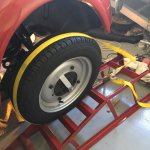I am already contributing to two threads that have involved this topic but I am keen to get some extra input from knowledgeable contributors who have done this job.
I think I can be sure that the hubs are correctly re-assembled with new seals bearings and that "resilient spacer".
Too resilient is my feeling. The ones that came out were correctly barrelled having been under tightening strain.
I seem not to be the first person to find that the new ones need seemingly excessive tightening and are still not collapsing as intended under load. I am unable to eliminate the free play on the axle and am reaching the highest torque on my 1/2" drive wrench
Do I just keep tightening or have I missed something?
There is already a useful thread with a link to a non Fiat video which shows the principle of this.
https://www.fiatforum.com/500-classic/324250-rear-wheel-bearings.html
I think I can be sure that the hubs are correctly re-assembled with new seals bearings and that "resilient spacer".
Too resilient is my feeling. The ones that came out were correctly barrelled having been under tightening strain.
I seem not to be the first person to find that the new ones need seemingly excessive tightening and are still not collapsing as intended under load. I am unable to eliminate the free play on the axle and am reaching the highest torque on my 1/2" drive wrench
Do I just keep tightening or have I missed something?
There is already a useful thread with a link to a non Fiat video which shows the principle of this.
https://www.fiatforum.com/500-classic/324250-rear-wheel-bearings.html
Last edited:




